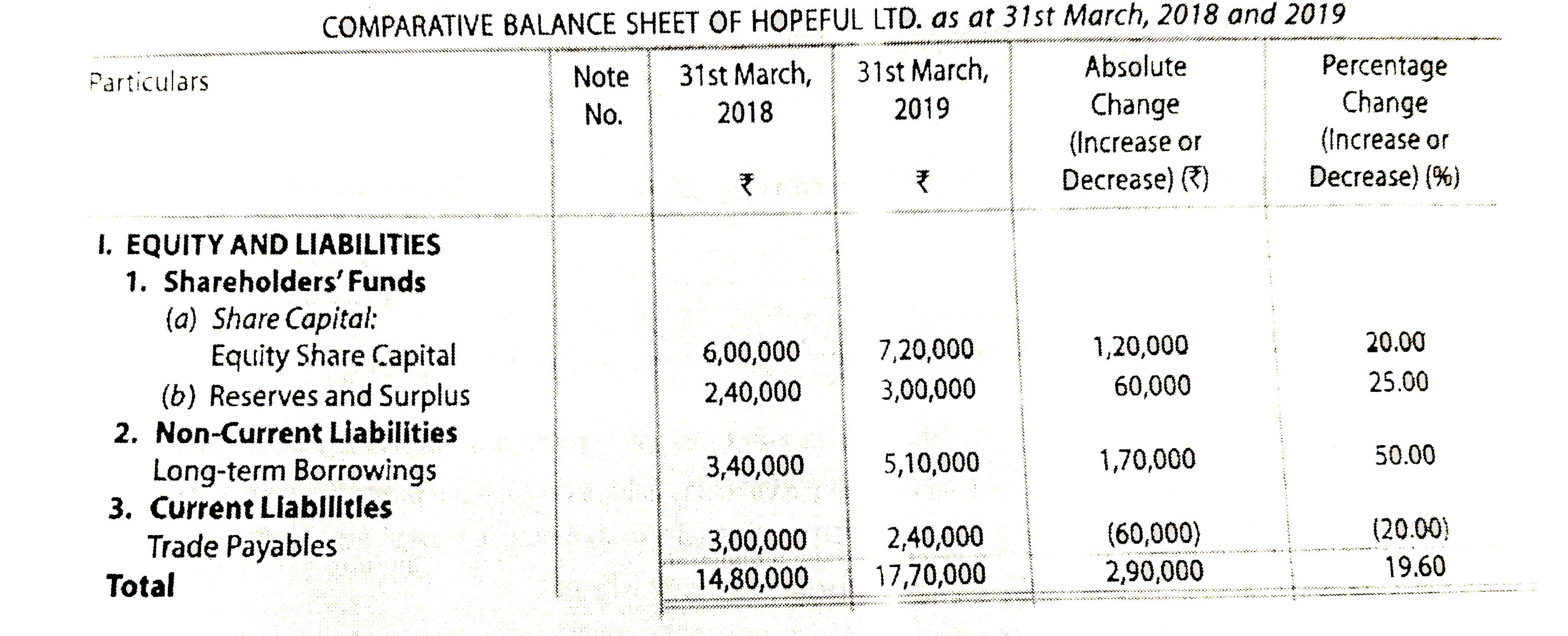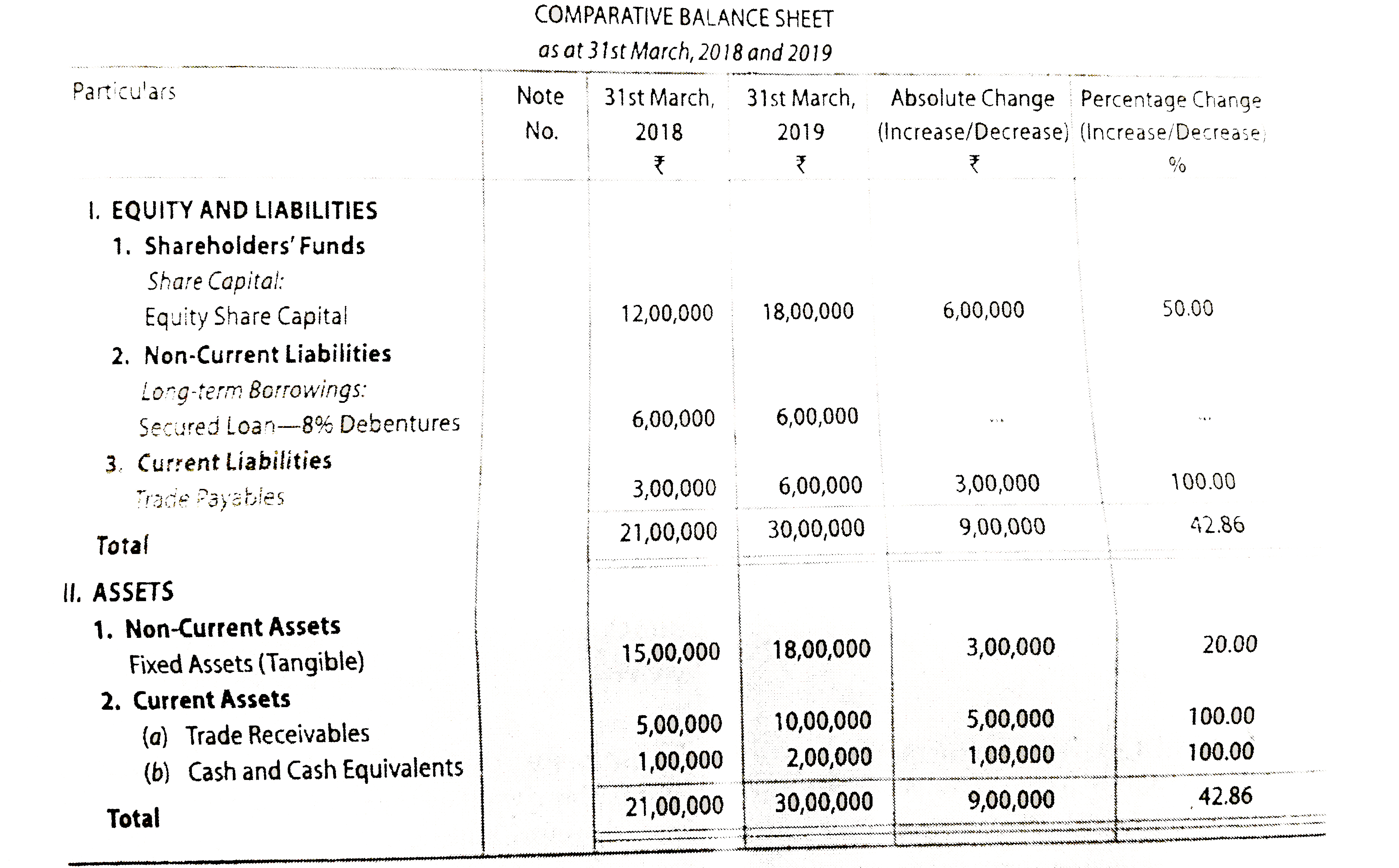Hopeful Ltd in the business of readymade garments, decided to take part in swachh bharat abhiyan by educating the people about the disadvantages of pollution and its effect on health. Its comparative balance sheet is given below:


Related Playlists
- BOOK - TS GREWALCHAPTER - ACCOUNTING RATIOS EXERCISE - Exercise147videos
ACCOUNTING RATIOS
- BOOK - TS GREWALCHAPTER - ACCOUNTING RATIOS EXERCISE - Exercise147videos
ACCOUNTING RATIOS
- BOOK - TS GREWALCHAPTER - ACCOUNTING FOR PARTNERSHIP FIRMS-FUNDAMENTALS EXERCISE - EVALUATION QUESTION :QUESTIONSWITHMISSINGVALUES3videos
ACCOUNTING FOR PARTNERSHIP FIRMS-FUNDAMENTALS
- BOOK - TS GREWALCHAPTER - Admission of a PartnerEXERCISE - EXERCISE107videos
Admission of a Partner
Knowledge Check
- Question 1 - Select One
What are the reasons for the people's resistance to the introduction of Bt brinjal in India ?
1. Bt brinjal has been created by inserting a gene from a soil fungus into its genome.
2. The seeds of Bt brinjal are terminator seeds and therefore, the farmers have to buy the seeds before every season from the seed companies.
3. There is an apprehension that the consumption of Bt brinjal may have adverse impact on health.
4. There is some concern that the introduction of Bt brinjal may have adverse effect on the biodiversity.
Select the correct answer using the codes given below:A1, 2 and 3 onlyB2 and 3 onlyC3 and 4 onlyD1, 2, 3 and 4 - Question 1 - Select One
Read the source given below and answer the questions that follows:
For comparing countries, their income is considered to be one of the most important attributes. Countries with higher income are more developed than others with less income. This is based on the understanding that more income means more of all things that human beings need. Whatever people like, and should have, they will be able to get with greater income. So, greater income itself is considered to be one important goal. The income of the country is the income of all the residents of the country. This give us the total income of the country. However, for comparison between countries, total income is not such a useful measure. Since, countries have different populations, comparing total income will not tell us what an average person is likely to earn. Are people in one country better off than others in a different country? Hence, we compare the average income which is the total income of the country divided by its total population. The average income is also called per capita income. In World Development Reports, brought out by the World Bank, this criterion is used in classifying countries. Countries with per capita income of US$ 12,056 per annum and above in 2017, are called rich countries and those with per capita income of US$ 955 or less are called low-income countries. India comes in the category of low middle-income countries because its per capita income in 2017 was just US$ 1820 per annum. The rich countries, excluding countries rbf Middle East and certain other small countries, are generally called developed countries.
Human Development Report published by UNDP compares countries based on the educational levels of the people, their health status and per capita income.
Who compares the development of the countries on the basis of literacy rate, gross enrolment ratio and health status of their people ?AUNDPBWorld BankCBoth A and BDNone of these - Question 1 - Select One
Read the following passage and answer the questions that follow.
The United Kingdom’s Social Mobility Commission study reports that disadvantaged children in England are being priced out of a cultural hinterland. Children aged 10-15 from low-income families are three times less likely than wealthier peers to engage in out-of-school musical activities, such as learning an instrument etc. There were also differences according to race – 4% of British Pakistani children took part in music classes, compared with 28% of Indian children and 20% of white children – and regional divides: 9% of children in north-east England played a musical instrument, compared with 22% in the south-east. Disadvantaged children are also more likely to miss out on extracurricular sports (football, boxing, cricket) and drama, dance and art. The commission set out recommendations, including bursaries, better funding and support for schools – let’s hope they’re taken on board. As well as the activities themselves, children are missing out on other crucial gains including confidence-building, team spirit and social skill, and are less likely to go on to higher education. Extracurricular activities tend to cost money, but there are also problems with a lack of availability and access, such as schools being unable to afford to run after-school clubs or stay open during holidays. Another barrier is the kids’ “fear of not fitting in”. In this sense, certain children are self-excluding from, say, learning an instrument, singing in a choir, playing cricket or acting. They decide by themselves that they’re “undeserving” of music, sport, art and drama. Unbelievably, in 2019, children as young as 10 are already hard-wired with the self-limiting poverty notion of “not for the likes of us”. This is heartbreaking. It’s hardly news that life is tougher for poorer children, but it’s an outrage if all sense of curiosity, artistry and playfulness is knocked out of them so early. Something is wrong if better-off children feel entitled to explore and participate in areas that interest and excite them, while the disadvantaged are cast from the start as cultural wallflowers – doomed to sit out every dance. This isn’t about every child learning the piano or violin (but why not?), it’s about sowing the seeds for a cultural hinterland that will sustain and enrich them for life. It’s about people exploring their passions and refusing to have their horizons artificially limited. Regardless of circumstances, all children should know that their faces “fit” – automatically and forever. Culture belongs to everyone.
How will a wholesome education including arts and sports not benefit the disadvantaged?AChildren will get exposure to arts and sports.BChildren will have feelings of low self-esteem and self-exclusion.CChildren will explore play and learning outside of class.DChildren will no longer have the fear of not fitting in.
Similar Questions
Usha ltd has a manufacturing base in rural area of andhra pradesh. As a corporate social responsibility it decided to join hands with municipal corporation in educating local population the advantage of cleanliness and contributed large amount in making the area clean following is its comparative balance sheet:
 View Solution
View SolutionHopeful ltd . In the business of manufacturing and selling FMCG decide to set up a new manufacturing unit in economically backward are of chattisgarh. It decided to employ factory staff from the local population. But before that it imp[arted training to them for six months and gave each trainee a stipend of Rs 5000 per month. given below is its comparatiabe balance sheet:
 View Solution
View SolutionAfter winning the election, prime minister Mr. Narender Modi launched a Compaign of Swachh Bharat' and invited various celebrities to be a part of this Abhiyaan. This spread awareness among the people in society and in general, people started becoming more careful and aware about the cleanliness around their area. to continue its impact, a new service tax for swachh bharat was also started. the government is planning to import new and better technology to adopt new methods of terating the garbage and waste.
State the variuos dimensions of business environement in the above para quoting the lines from the above para.View SolutionBelow in the question are Given two statements (A) and (B).These statements may be either independent causes or may be effects of independent causes. One of these statements may be the effect of the other statement. Read both the statements and decide which of the following answer choice correctly depicts the relationship between these two statements. Mark answer
1) if statement (A) is the cause and statement (B) is its effect.
2) it statement (B) is the cause and statement (A) is the effect.
3) if both the statements (A) and (B) are independent causes.
4) if both the statements (A) and (B) are effects of independent causes.
5) if both the statements (A) and (B) are effects of some common cause.
A. The state govt has decided to boost English language education in all the schools from the next academic year.
B. The level of English language of the school students of the State is comparatively lower than that of the neighbouring states.View SolutionSomnath Ltd. Is engaged in the business of export of garments. In the past, the perfomance of the company had been upto the expectations. In line with the latest technology , the company decided to upgrade its machinery. For this , the finance Manager, Dalmia estimed the amount of funds required and the timings. This will help the company in linking the investment and the financing decisions on a continuous basis. Dalmia therefore began with the preparation of a sales forecast for the next four years. He also collected the relvant data about the profit estimates in the coming years. By doing this , he wanted to be sure about the abailability of funds from the internal soures of the business. for the remaining funds he is trying to find out alternative sources from outside.
Identify the financial concept discussed in the above para. Also state the objectives to be achieved by the use of financial concept, so identified.View SolutionA student of Delhi University, Raghavendra Parpanna, wanted to study the role of decentralisation in decision making about primary education. He asked some questions to the villagers. These questions are given below. If you were among those villagers, what answer would you give to each of these questions ?
A meeting of the Gram Sabha is to be called to discuss what steps should be taken to ensure that every child of the village goes to the school.
In the Gram Sabha meeting firestly a cirular sent by the district collector was read. It suggested what steps should be taken to organise on education rally and what should be its route. The meeting did not discuss about the children who never come to school or about girl's education, or the condition of the school building and the timing of the school. No women teacher attended the meeting as it was held on Sunday. What do you think about these proceedings as an instance of people's participation?View SolutionBelow in each question are given two statements I and II . these statements may be either independent causes or may be effects of independent causes or a common cause. One of these statements may be the effect of the other statement Read both the statement and decide which of the following answer choice correctly depicts the following answer choice correctly depicts the relationship between these two statements
Make answer (a) If statement I is the cause and statement II is its effect.
Make answer (b) if statement II is the cause and statement I is its effect.
Make answer (c) If both the statement I and II are independent cause
Make answer (d) If both the statement I and II are effects of independent causes.
Mark answer (e) If both the statement I and II are effects of some common cause.
I. The government has decided to take strict action against the builder responsible for the construction of the bridge for having used low quality material thereby risking several lives.
II. The government has decided to build a vehicular bridge over the river connecting the suburban area to the city in order to reduce the traffic load on the main road.View Solution


